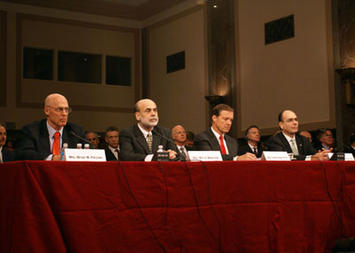
Federal Reserve Chairman Ben Bernanke testified before the Senate Budget Committee on Tuesday (March 3, 2009), the day after it was announced that AIG would be back at the federal teat for another $30 billion. The generally subdued Senate was nonetheless forceful in getting Bernanke to admit several things:
- The Fed and Treasury are using the same three rating agencies to help them select triple-A collateral for bailout lending as were used to get triple-A credit ratings for junk mortgage bonds;
- Neither the Fed nor the Treasury will tell us all the companies that are getting bailout money;
- There is no “outer limit” to how much money the US government can print;
- No one knows the “outer limit” of how much money the US government can borrow;
- The “too big to fail” policy is a bigger problem than anyone thought it could be;
- No one was in charge of AIG – not bank regulators, insurance regulators or capital market regulators.
When asked about AIG several times, Bernanke replied that it’s “uncomfortable for me, too.” Through some hole in the regulations, the insurance regulators had no authority to monitor the financial products activities of AIG. Explained simply and bluntly, the world’s largest insurance company sold credit default swaps (CDS, insurance against default) on the junk bonds issued from mortgages and consumer purchases. Many of those mortgages and consumer purchases were made foolishly – when the borrowers failed to repay the loans the bonds also failed. The people and companies that bought CDS on those bonds did not look too closely at AIG to see what would happen if the bonds failed. As it turns out, they didn’t have to worry about AIG failing – AIG was deemed too big to fail.
When the bonds defaulted and the buyers of CDS protection (“counterparties”) turned to AIG for payment, AIG turned to the federal government for help. The AIG bailout has cost $180 billion so far for which the US government owns 80 percent of a company that lost $61.7 billion in three months (for a total of $99.29 billion in 2008, an amount equal to all of their profits back to about 1990).
Here’s a tough question: Why won’t the Fed disclose who is benefitting from the CDS payoffs? Bernanke made a comparison between your grandmother and AIG: like the owners of life insurance policies, the purchasers of financial insurance “made legal legitimate financial transactions. They have a right to privacy about their financial condition.” In other words, no one should know how much life insurance your grandmother has. That’s why the Fed won’t tell us who bought the CDS insurance on junk bonds! Senator Ron Wyden (D-OR) asked him to “come clean.” Senator Bernard Sanders (I-VT) asked point blank: tell us who got the $2.2 trillion loaned by the Fed. He got a one word response for his troubles: “no.”
Bernanke said, “AIG made me angry...This was a hedge fund attached to an insurance company. We had to step in, we really had no choice. It’s a terrible situation, but we aren’t doing this to bailout AIG, we’re doing it to protect the broader economy.”
Here’s how you connect the dots from AIG to main street: AIG is an insurance company and insurance companies are among the “safe” investments that money market mutual funds are allowed to invest their cash in – in fact most funds are required to keep some portion of their assets in these supposedly risk-free investments.
Basically, this requirement is there to make sure that cash will be available to meet the withdrawal requests from investors. Now, money market mutual funds and mutual funds are a favorite investment for retirement money, including the 401k plans that many people have through their employers. But also, your employer’s retirement plan money is likely also invested in these funds. Pensions can hold stocks and bond directly, but as the size of these plans gets bigger and bigger, it becomes increasingly difficult for one or a few investment managers to handle everything. The California State Teachers Retirement System and the California Public Employees Retirement System (Cal STRS and Cal PRS, for short), the largest pension funds in the world, have $160 billion and $180 billion in assets to invest. So, propping up AIG means that the investments made in the stocks, commercial paper, policies, etc. issued by AIG will not collapse and take with them the retirement assets of many millions of Americans.
In the final round of questions, Senators Warner (D-VA) and Wyden (D-OR) were especially clear on the point of finding out who is benefitting from the bailout of AIG. AIG was a good insurance company, Warner said, but their London-based financial products division started selling CDS into Europe. Now, American taxpayers are being asked to pick up the tab. Why does AIG continue to make the payouts when they require federal money to continue to exist? The Senators suggested that, at a minimum, Americans deserve to know who is benefitting from the CDS payouts. “It’s time for some sunlight.”
Susanne Trimbath, Ph.D. is CEO and Chief Economist of STP Advisory Services. Her training in finance and economics began with editing briefing documents for the Economic Research Department of the Federal Reserve Bank of San Francisco. She worked in operations at depository trust and clearing corporations in San Francisco and New York, including Depository Trust Company, a subsidiary of DTCC; formerly, she was a Senior Research Economist studying capital markets at the Milken Institute. Her PhD in economics is from New York University. In addition to teaching economics and finance at New York University and University of Southern California (Marshall School of Business), Trimbath is co-author of Beyond Junk Bonds: Expanding High Yield Markets.












